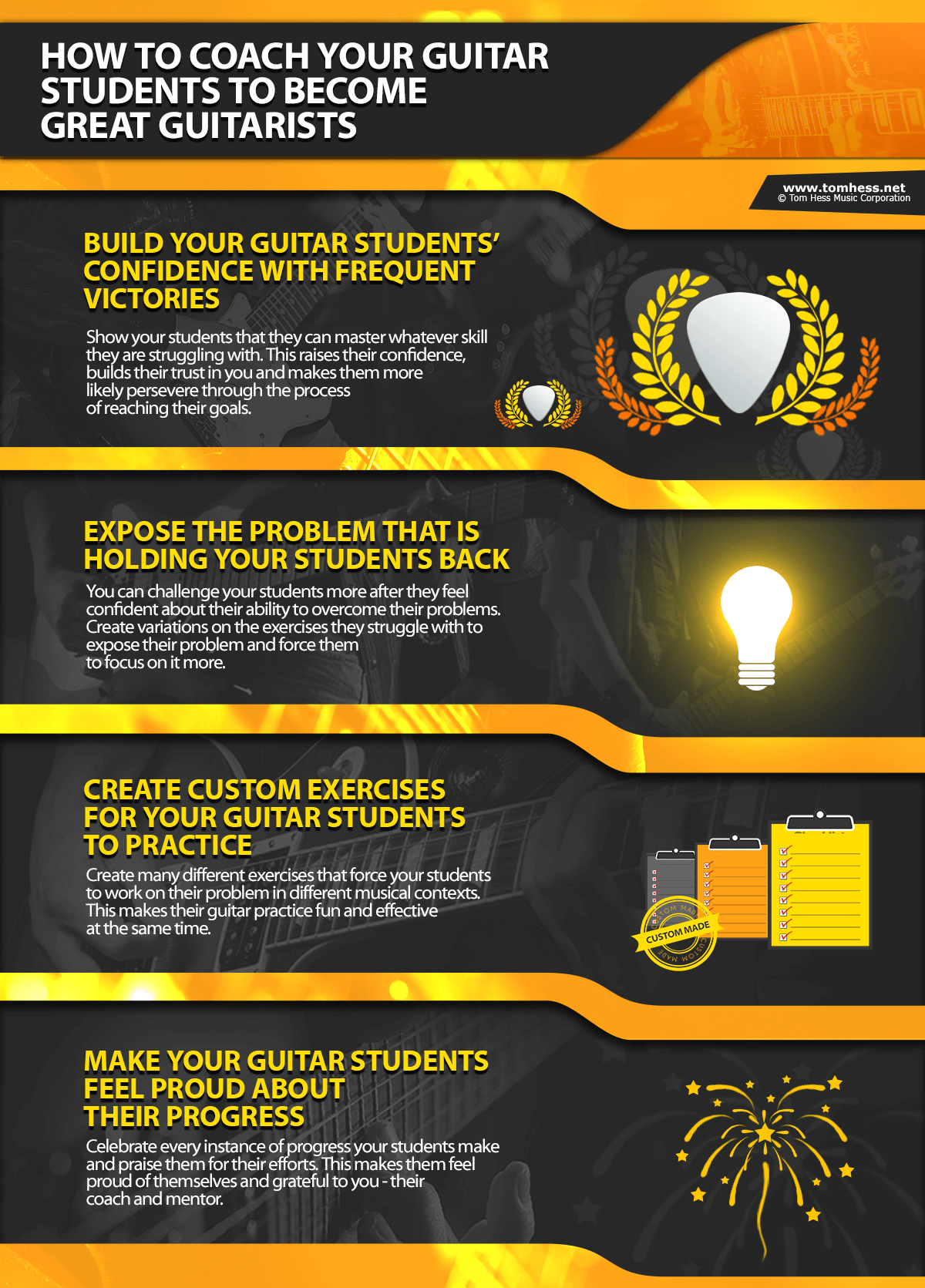How To Help Your Guitar Students Become Great Guitarists Faster

By submitting your info, you agree to send it to Tom Hess Music Corporation who will process and use it according to their privacy policy.
Being a great guitar teacher is about a lot more than just teaching guitar.
Guitar teaching is also about:
- Training your students to practice correctly (a great guitar teacher knows how to train them during their guitar lessons), so they see consistent progress and feel motivated to practice guitar on their own in between guitar lessons.
Most guitar students are not lazy. They simply never learned how to practice the right way (right in their guitar lessons with an expert guitar teacher)... this is why most don't practice as much as they should.
This means you have an opportunity to help your guitar students in ways an average guitar teachercannot (more on this below). Plus: your job as a guitar teacher becomes way easier once you get good at this.
- Becoming not just a guitar teacher, but a guitar coach to your guitar students and motivating them to believe in their musical potential, so they consistently do what you tell them to do. (You can do this both during their guitar lessons and in between their lessons.)
This is the hardest guitar teaching challenge for your average guitar teacher. Without this coaching (which ought to be part of all great guitar lessons), your guitar students lose their motivation, stop believing in their own potential and in you as their guitar teacher... and when that happens - guitar students quit.
The better you are at training your guitar students to practice and keep a positive mindset, the longer your guitar students stay with you, the happier they feel about your guitar lessons, and the more successful you become as their guitar teacher.
Check out this video to see how to become a better guitar teacher and train your guitar students to make rapid progress in their playing:
Guitar teaching is the process of communicating knowledge and musical concepts to your students. Training and coaching are about helping your guitar students understand, apply and integrate their knowledge. All of this should happen during your students' guitar lessons.
Great guitar teachers are masters of all 3 skills. This is a big reason why many of their students become great musicians very quickly. Excelling in all 3 areas also makes it easy to teach your students in innovative ways and earn more money teaching guitar.
Your average guitar teacher only teaches. But beyond guitar teaching, he never coaches or trains his guitar students. This is one reason why the average guitar teacher does not have many great guitar students. An average guitar teacher struggles to get his students to practice and master their lesson materials.
Excelling in all 3 areas of guitar teaching also makes it easy to teach your guitar students in innovative ways and earn more money teaching guitar.

By submitting your info, you agree to send it to Tom Hess Music Corporation who will process and use it according to their privacy policy.
These guitar teaching tips help you become a coach and trainer for your students:

Guitar Teaching Tip #1: Build Your Guitar Students’ Confidence With Frequent Victories
Show your guitar students that they can master whatever skill they practice and struggle with in their guitar lessons. This raises their confidence in you as their guiatr teacher, builds their trust in your guitar teaching skills and makes them more likely to take guitar lessons with your for a long time.
You build your guitar students’ confidence by simplifying problems they struggle with (during their guitar lessons) to make them easier to solve when they practice at home. THIS is the mark of a truly great guitar teacher.
Example: Your guitar student may struggle to play a guitar lick like this:

And during your guitar lessons, your student may play each measure of this lick cleanly and up to speed, but struggle to put them together.
Your first guitar teaching goal during guitar lessons is to prove to your student that he can play this passage. A great guitar teacher can do this without slowing the lick down or making his guitar students practice anything hard.
Here is how: sustain the note at the end of the first measure to give your guitar students more time to think and prepare the hands to switch to the 2nd measure.
Example:

Sustaining the last note of the 1st measure creates a variation on the guitar lick that is much easier to play than the original. This allows your guitar students to practice both measures at performance speed (without slowing down).
After you build your student’s confidence, make the transition note shorter and shorter until he can play the original lick at the right speed. THIS is how you train your guitar students the right way during your guitar lessons.
This strategy is particularly effective with weak-minded guitar students (those who easily become frustrated by challenges and have lower self-esteem). The faster you can help such students see results, the easier it becomes to keep them motivated long-term.
This approach also strengthens the mindset of your students and helps them handle more demanding guitar practice challenges (more on this below).
Question: “Tom Hess, how can I apply this guitar teaching style to other challenges my guitar students may struggle with in their guitar lessons with me?”
Answer: Most of your guitar students’ problems are caused by their ears and brain, NOT by their hands. You have to realize this when you become a guitar teacher. Their ears are not able to keep up with their hands. In your guitar lessons, find a way to reduce the number of things your students’ brain has to focus on at once. This makes solving problems feel a lot easier and makes you a more confident guitar teacher.
Watch the video at the top of the page to see another example of giving your guitar students frequent victories during your guitar lessons.
Want to learn more about being a great guitar teacher? Take this guitar teaching test to see how good you are as a guitar teacher today and learn simple things you can do to teach guitar lessons better for your guitar students.
Guitar Teaching Tip #2: Expose The Problem That Is Holding Your Guitar Students Back
An expert guitar teacher can challenge his guitar students more after they feel confident in their ability to overcome their problems.
Here is how a great guitar teacher may do this during guitar lessons:
Create variations on the exercises your guitar students are practicing. Your variations must expose their problem and force your guitar students to focus on it more.
Watch the video (starting at 3:13) to see how creating variations on your guitar students’ problems helps them improve faster.
Variations can expose the problem in 2 ways for your guitar students:
- Make the problem harder. Example: ask your guitar students to play a guitar lick with difficult fretting hand stretches lower on the fretboard (where the frets are further apart). And your job as a guitar teacher is to make sure your guitar students are playing this harder variation correctly.
- Make the problem come up more frequently. Example: ask your guitar students to repeat a difficult picking hand motion more than once in a lick. This guitar teaching challenge gives your guitar students more chances to practice it.
This guitar teaching video shows more examples of creating variations on your students’ guitar playing challenges (you can use these ideas to run your guitar lessons better):
Common guitar teaching mistake: the average guitar teacher starts by exposing their guitar students’ problems before building their confidence, earning their trust and identifying their personality type. This is how NOT to teach guitar lessons. Such an approach often fails because most guitar students are weak-minded. Weak-mined guitar students:
- Crumble easily under pressure
- Feel bad about themselves when you expose their mistakes in their guitar lessons
- Don’t feel confident (yet) about their ability to overcome challenges and reach their goals.
- Don’t fully trust you or feel confident in your ability to help them reach their goals.
Most guitar students quit their guitar lessons with you because they don't like the process of facing their challenges and practicing to overcome them.
Strong-minded guitar students are self-motivated, focused and determined to reach their goals. Those students can handle a more direct approach to solving their musical problems. However, the majority of guitar students in the world are weak-minded.
This step of the coaching process determines how quickly your students improve their skills and reach their goals. Being an effective guitar teacher helps you keep your guitar students studying with you for years.
Question: “Tom Hess, I’m thinking of ways to create ‘quick wins’ for students who struggle with delayed gratification. It seems many of them revolve around temporarily making things they’re playing easier than they really are. (Like: playing something with legato vs. picking.) But how do you apply this to teaching things that are either advanced (like string skipping) or don’t make their playing instantly better? (Like posture, for example.)”
Answer: It’s less important to create quick wins for truly hard (advanced) topics. Since students have to be at least somewhat good at delaying gratification to even become advanced enough to practice them.
Which... just leaves the ‘borings’ topics.
And the trick here is:
Break up the boring topic into tiny splinters students can learn so fast and so easily... they won’t have a chance to even become bored.
For example, when it comes to teaching students ‘posture’ - teach THIS first.
And then (this is key), after your students do what you tell them...
Praise the heck out of them and sell them on the benefits of what they ‘just’ did.
E.g. once they fixed their sitting position, tell them all the things they’ll now find easier when they play and practice.
That praise becomes their “quick win”... even if doing what you told them hasn’t yet made their playing better in any obvious way.
(Ironically, for many people - hearing praise from their guitar teacher is almost worth more than improvement in their actual playing.)
Repeat that lesson after lesson, until the student has learned what they need to learn without even realizing they’ve been doing “boring and hard” work that entire time.
And before they know it, enough time has passed that they ‘actually’ see results in their playing... which makes them feel all the better.
That is just one of the tricks to making students feel good about themselves and their progress each time they sit in front of you.
Guitar Teaching Tip #3: Create Custom Exercises For Your Guitar Students To Practice
Giving your students instant victories helps them believe in their potential to improve as musicians.
Exposing the true causes of their problems gives your students a path to follow to become great guitar players.
It's important to make your students’ guitar practice effective and fun at the same time. This keeps them engaged all through the process of reaching their goals.
Create many different exercises that force your students to work on their problem in different musical contexts. Here is how you can do this in your guitar lessons:
- Show you students how to transpose a lick into another scale or key.
- Create several (different) guitar licks for them that contain the same guitar technique challenge(s).
- Create a musical etude from the original guitar lick, to integrate it into real-life guitar playing.
Here is a video example of how to do this:
Your students now have many exercises to choose from that address their core problem. They can choose any of the exercises you created for them and work on the problem until it is mastered, without becoming bored. The more fun your guitar students have while practicing, the more time they spend practicing. The more time they practice, the faster they become great guitar players.
The more great students you have, the faster your positive reputation spreads around your local area. This helps you attract a lot more guitar students and earn more money teaching guitar.
Question: “Tom Hess, this guitar teaching approach sounds like a lot of work! Am I supposed to create dozens of unique exercises for every problem all of my guitar students have in their guitar lessons?”
Answer: You don’t need to reinvent the guitar teaching wheel for every guitar student you have. The longer you teach guitar, the more guitar teaching similarities you find in the problems your students have. You can reuse exercises you’ve created to help other guitar students as long as they match the needs of the current student you are teaching.
This goes much deeper than saying “good job” when your students master something. You must remind your students of:
- How frustrated they were when they first began to work on their problem.
- How much work they put in to get the result they wanted.
- How much better their guitar playing sounds now compared to before.
- How their guitar practice efforts have created the result they are now enjoying.
You also must tell your students that every guitar playing challenge they conquer makes them more free to express themselves as musicians.
Guitar Teaching Tip #4: Make Your Guitar Students Feel Proud About Their Progress
Celebrate every instance of progress your students make and praise them for their efforts. This makes them feel proud of themselves and grateful to you - their guitar teacher, trainer and coach.
This goes much deeper than saying “good job” when your students master something. You must remind your students of:
- How frustrated they were when they first began to work on their problem.
- How much work they put in to get the result they wanted.
- How much better their guitar playing sounds now compared to before.
- How their guitar practice efforts have created the result they are now enjoying.
You also must tell your students that every guitar playing challenge they conquer makes them more free to express themselves as musicians.
Question: “Tom Hess, do I really have to tell my students all this after every victory? Aren’t these things obvious and common sense?”
Answer: These things are NOT obvious (to most of your guitar students). Your students often don’t give themselves enough credit about their progress. They exaggerate their problems and weaknesses (in their mind) and take their progress for granted. Most also do not see the big picture of their musical progress. They let themselves become distracted easily and lose focus.
Part of your job as a guitar trainer and coach is to keep your guitar students focused on the result they want. You do this by reminding them how far they have come and how much more exciting the rest of the journey is.
Now that you know the best way to teach guitar, the next step is to test your guitar teaching skills & learn how to become a better guitar teacher for your students. Take this guitar teaching test and learn how to become the guitar teacher your students will feel proud to study with.

Learn how to become a very successful guitar teacher.
